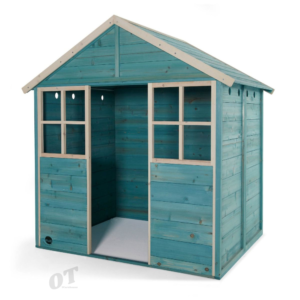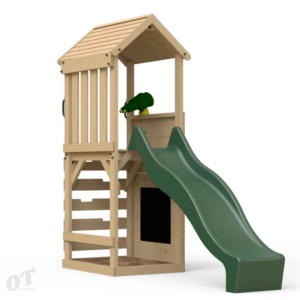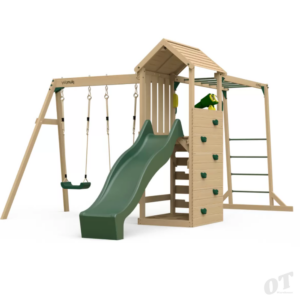The Cubby House: A Place for Kids to Play and Imagination to Grow
A cubby house is a small, often wooden, playhouse for children. They are typically built in backyards and used as a place for children to play. Cubby houses often have a few windows and a door, and sometimes include a deck or porch. Some are even built with electricity and include lights and outlets.
How big is a cubby house?
Cubby houses come in a range of different sizes. However, a typical cubby house is usually around 1.5 to 2 meters wide and 1 to 1.5 meters tall. we can also attach different products to the side, included are swings, sandpits, monkey bars, seesaw,, and toy slides.
How many people can fit in a cubby house?
Usually, between 4-6 people, depending on the size. The average size of a wooden cubby house is around 2.4m x 2.4m, with an internal height of around 1.8m. However, there are smaller and larger sizes available on the market. Don't purchase too small if your children are 5 as they start to grow fast.
What are the benefits of having a cubby house?
There are many benefits of having a cubby house for children. It can provide them with a place to play and explore, while also giving them a sense of independence. Cubby houses can also help to develop a child's imagination and creativity. Additionally, they can help to promote physical activity and social interaction.
What are the different types of cubby houses?
There are many different types of cubby houses, but the most common are wooden ones. They can be made out of recycled materials or new materials, and they can be either simple or complex in design. Some common features of cubby houses include a door, windows, a chimney, and a porch. Some more elaborate designs may also include a kids slide, a cubby house with swing, or a climbing wall.
Facts:
1. A cubby house is a small, often wooden, playhouse for children.
2. Cubby houses are usually built in backyards and are a place for children to play and use their imaginations.
3. Cubby houses can be simple or elaborate, and many children love to decorate and personalize their own cubby houses.
4. Cubby houses often have windows, doors, and sometimes even a porch or deck.
5. Many cubby houses also come with furniture, such as chairs, tables, and beds, so children can pretend they are in their own home.
6. Cubby houses can be bought or homemade, and many families enjoy building their own cubby houses together.
7. Cubby houses provide a great opportunity for children to play and explore, and can help them develop important social and motor skills.
How long does it take to build a cubby house?
It really depends on the size and complexity of the cubby house. A simple, small cubby house might only take a few hours to build, whereas a larger, more complex one could take a day or two. Ultimately, it really depends on the individual circumstances. for those that are not savvy about building a handyman should be able to assemble it in 4-6 hours max.
How much does a cubby house cost?
A cubby house can cost anywhere from $100 to $5,000, depending on the size, materials, and features. The most basic cubby houses are made from wood and plastic and can be found at most toy stores. These types of cubby houses usually cost between $350 and $1000. More elaborate cubby houses made from wood, metal, and stone can cost between $500 and $5,000.
How easy is it to maintain a cubby house?
Assuming you are referring to a wooden cubby house, they are actually quite easy to maintain. A yearly coat of weatherproofing stain or paint will help protect the wood from the elements and extend its life. You may also need to occasionally tighten screws or bolts as the house settles.
Statistics:
1. The average price of a cubby house is $500.
2. The average size of a cubby house is 2x2x2.4m.
3. Cubby houses are made from a variety of materials, including wood, plastic, and metal.
4. The most popular color for a cubby house is blue.
5. The average weight of a cubby house is 50kg.
6. Cubbyhouse can be decorated with a variety of accessories, including furniture, curtains, and lights.
7. Most cubby houses have a door and at least one window.
8. The average life span of a cubby house is 10 years.
9. Cubby houses can be used for a variety of purposes, including play, storage, and sleeping.
10. More than 50% of children in Australia have cubby house.
What are the safety features of a cubby house?
When it comes to safety, there are a few things to consider with a cubby house. The most important factor is the location of the cubby house. It should be placed in an area away from any potential hazards, such as busy streets or bodies of water. The cubby house should also be sturdy and well-constructed. Don't place them under trees that drop a lot of limbs or branches that can smash into them.
Also remember once a year to check for loose screws and boards.
What is the construction process of a cubby house?
Building a cubby house is a fun and rewarding experience that the whole family can enjoy. The construction process is not as difficult as you might think, and with a little planning and some elbow grease, you can have a beautiful cubby house in your backyard in no time.
The first step in building a cubby house with slide is to decide on the size and style of the house. There are many different plans available online or in home improvement stores.
Where can I purchase a cubby house?
There are a few places you can purchase a cubby house. One option is to go to a store that specializes in selling outdoor play equipment for children. Another option is to look online, as there are many websites that sell cubby houses. You can also check classified ads to see if there are any families selling a used cubby house. OTwarehouse has some Quality Australian approved cubbies that are shipped all over Australia, delivery items to your door.




